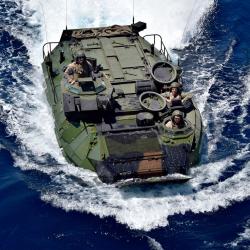
Photo:Mass Communication Specialist 1st Class Daniel Barker/Navy
One Marine died and two were critically injured on Thursday off the coast of California when an amphibious assault vehicle (AAV) from the 15th Marine Expeditionary Unit took on water and sank rapidly. Seven Marines and one Navy sailor are missing and feared dead.
Marine Corps Times reports that the AAV was returning to the amphibious transport dock USS Somerset after conducting a training raid at San Clemente Island, California. The vehicle had 15 Marines and one sailor aboard at the time, according to the document and later confirmed by the Marine Corps.
“26 tons sinks really fast,” Jacob Aronen, who previously served as a corporal with the 3rd Assault Amphibian Battalion, told Marine Corps Times Friday.
Aronen said the main way to escape a sinking AAV is through the top hatches, “which often have handles that are so stiff you need to beat them with a hammer to open.”
He added the weight of the hatches often requires two Marines to push open and would get even heavier as the vehicle goes underwater.
If the Marines are unable to get the hatches open before the vehicle sinks under more than three feet of water, opening them would become “extremely difficult if not impossible,” said Tagen Schmidt, a veteran AAV crewman.

Decades ago San Clemente Island was one of my favorite abalone gathering areas. The windard side of the island has very strong surg and very steep inclined into deep water. Assault vehicle may be accessible by special Naval dive units( robotic).
Condolences to families and Navy.
No way to blow the hatches, shouldn’t take much force.
Condolences to any family
As both an enlisted Marine and then a Naval Reserve Officer, we always trained with the maxim “The more you sweat in peacetime, the less you bleed in war.” Unfortunately, sometimes we bleed in peacetime. We need to minimize that and learn from tragic events such as this.
The picture shows the hatches open outward. It would be very hard, if not impossible, to blow these. I wonder if having one escape hatch that opens inward might be a better idea. Once the AAV was flooded, it would be easier to escape. Remembering Navy damage control training in flooded compartment simulators as a result of lessoned learned from Pearl Harbor.
Semper Fi Marines! I hope lessons are learned and your sacrifice is not in vain.